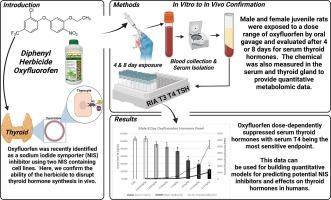Evaluation of the diphenyl herbicide, oxyfluorfen, for effects on thyroid hormones in the juvenile rat
Abstract
Recently, oxyfluorfen, a pre- and post-emergent diphenyl ether herbicide, was identified in our laboratory as an inhibitor of iodide uptake by the sodium iodide symporter (NIS), the first key step in the synthesis of thyroid hormones (THs). This inhibition was observed in vitro, using both a human NIS engineered cell line (hNIS-HEK293T-EPA) and a rat thyroid follicular cell line (FRTL-5). Oxyfluorfen was found to be a potent inhibitor of NIS activity with an EC50 of approximately 2 µM in both cell lines with no observed cytotoxicity at any concentration tested up to 100 μM. The current research tested the hypothesis that oxyfluorfen alters circulating concentrations of THs. This hypothesis was first tested in a pilot study with both juvenile male and female rats exposed to oxyfluorfen for 4 days at 0, 125, 250 and 500 mg/kg/day. Once we identified that this short-term 4-day oxyfluorfen exposure suppressed both total serum thyroxine (T4) and triiodothyronine (T3) at all doses, we tested seven lower concentrations of oxyfluorfen (0.8125 to 62.5 mg/kg day) in an 8-day exposure paradigm to more closely evaluate the dose–response. We found that oxyfluorfen suppressed serum T4 with a LOEL of 3.25 mg/kg/day and T3 with a LOEL 62.5 mg/kg/day. Analytical chemistry of the serum showed an accumulation over time following oral exposure to oxyfluorfen in both the 4- and 8-day groups. Analytical chemistry of the thyroid glands in the 8-day study revealed higher accumulation in the thyroid as compared to the serum (2 to 3- fold at 62.5 mg/kg). No changes in thyroid weight or serum TSH were observed following the 8-day exposure. This study is the first to demonstrate an effect of oxyfluorfen on serum thyroid hormones in the rat. Additional studies are needed to further evaluate the effects on thyroid homeostasis with extended exposures and the potential implications of the observed effects.


 求助内容:
求助内容: 应助结果提醒方式:
应助结果提醒方式:


